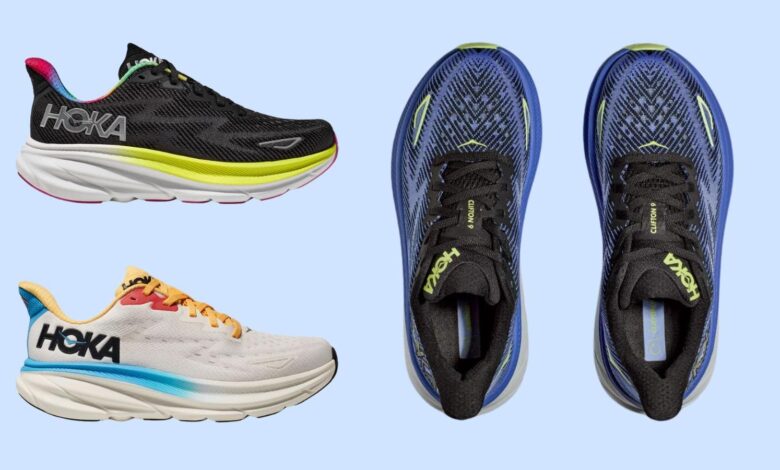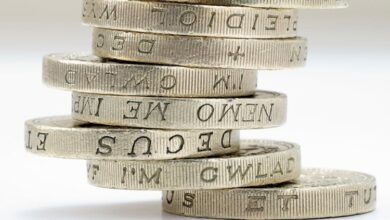Best Hoka Shoes For Walking 2024

Whether you log miles for fitness, travel or just part of your regular day, the best Hoka shoes for walking give you a noticeable boost—in comfort, stability, support and cushioning. All that makes it easier to power through long days, tough workouts and hard surfaces underfoot. While Hokas are extremely versatile, each pair has its own unique features that lend it to a specific type of walking. After interviewing experts—including a podiatrist, walking fitness pro and more—we picked the Clifton 9’s as the best Hoka shoes for walking overall since they’re lightweight, breathable and responsive to most types of strides. For more customized needs, the Ahari 7 is great for enhanced stability and the Mach 6 is the most comfortable for wide feet. Here’s what else scored highest in our analysis of the best Hoka walking shoes.
We put Hokas to the test to find out which work best for different types of walking.
-
Best Hoka Shoes For Walking Overall: Hoka Clifton 9
-
Most Stable Hoka Shoes For Walking: Hoka Arahi 7
-
Best Cushioned Hoka Shoes For Walking: Hoka Bondi 8
-
Best Everyday Hoka Shoes For Walking: Hoka Transport X
-
Best Hoka Shoes For Walking Long Distances: Hoka Gaviota 5
-
Best Wide Hoka Shoes For Walking: Hoka Mach 6
Sizes: 5-12 (W), 7-16 (M) | Width: Regular, Wide | Heel-to-toe drop: 5mm | Heel stack: 29mm (W) and 32mm (M)
- What’s notable: It’s an excellent lightweight shoe with a balanced mix of cushioning and stability.
- What could be better: If you’re used to a lower-profile sneaker, the stacked heel may take some getting used to.
The Clifton 9 scored highest in our review for many reasons. The vegan mesh upper features molded EVA foam in the midsole for pillowy comfort, a gusseted tongue keeps out dirt and debris, and a thick rubber outsole and MetaRocker technology put spring in your step. Hoka recently made the Clifton 9 even more lightweight by shaving off 4 grams, and they added more heel stack for extra cushioning. If you walk outside in all weather, consider paying the extra $15 for the GTX version, which is weatherproof and has reflective details to keep you visible on the roads.
What the expert says: Walking expert Joyce Shulman, CEO of 99 Walks and Jetti Fitness and author of Why Walk? has tested many sneakers. “Cliftons remain my favorite,” she says. “They are very comfortable, well-cushioned and provide the perfect support.” Dr. Brad Schaeffer, a board-certified foot surgeon and podiatrist at Central Park Sole in New York City runs in Clifton 9s and says they are excellent for walking, too.
Sizes: 5 to 12 (W), 7 to 15 (M) | Width: Regular, Wide | Heel stack: 27 mm (W), 29mm (M)
- What’s notable: This shoe has a sleeker profile than most other Hokas, which increases stability, and the extended heel pull makes them faster to get on and off.
- What could be better: It’s not as lightweight and flexible as some of Hoka’s other models, and it runs narrow.
This is a true stability shoe that prevents feet from over-pronating (where the foot tends to roll inward) and even though it’s cushy, this sneaker doesn’t feel wobbly when you’re walking at a fast clip. It has a j-shaped frame, which helps guide the foot into a more neutral alignment and keep you stable as you stride (without feeling restrictive), and the flat knit breathable upper adds extra support and ventilation. There’s also an extended heel pull and a plush tongue.
What the expert says: If you have balance issue, are unstable when you walk or overpronate, Schaefer is a big fan of this Hoka shoe. “It’s supportive without sacrificing cushioning,” he says, adding that he recommends replacing the standard insoles with a Dr Scholl’s orthotic or a custom orthotic from your podiatrist to add even more stability.
Sizes: 5 to 12 (W), 7 to 16 (M) | Width: Regular, Wide, X-Wide | Heel stack: 31mm (W), 33mm (M)
- What’s notable: This pair is exceptionally comfortable, with extra cushioning to prevent foot fatigue, and it comes in a range of widths.
- What could be better: That supersized sole may not appeal to all.
Hoka is known for making the most cushiony walking shoes, and the Bondi 8 is the cushiest of all. The shoe feels like walking on clouds thanks to layers of soft, lightweight foams, and updates include a pillowed tongue, a sockliner, and an extended heel. A shoe this plush can sometimes feel unstable but a rear “crash pad” will keep feet in line.
What the expert says: The rocker bottom sole is in full display on the Bondi 8. “It provides a nice landing and propels you forward in a controlled way,” says Dr. Schaeffer. This makes striding feel smoother and easier because the rocker helps you push off.
Sizes 4 to 15 (unisex sizing) | Width: Medium | Heel stack: 30mm
- What’s notable: This is a crossover shoe that’s stylish for every day but still athletic enough when you’re on the go for hours. Reflectivity keeps you visible when walking down the street.
- What could be better: It’s not available in wide widths, and it may not be as durable as other Hokas.
On casual days you don’t need the same amount of support as you would to, say, walk an entire city or go for a long walk in the woods. The all-gender Transport X is breathable, lightweight and has ample cushioning in the midsole. The outsole is made from “sticky” rubber, which prevents you from slipping on rain-slicked streets, and the shoe offers reflectivity to improve visibility outdoors. Finally, a sneaky carbon fiber plate helps you stride more smoothly and efficiently.
What the expert says: Shulman views this as a solid walking shoe “with a tread that’s best for on-road walking.” This is all you need for cruising around town, but if you do take to the trails, you would need a more substantial, grippier tread (Shulman recommends the Hoka Skyline-Float).
Sizes 5 to 12 (W), 7-15 (M) | Width: Regular, Wide | Heel stack: 34mm (W), 36mm (M)
- What’s notable: This a cushy shoe for tackling long treks that also offers some stability.
- What could be better: It runs a bit narrow.
Long walks can cause aches and pain over time. That’s why you want a shoe that’s well cushioned to keep feet feeling fresh and bouncy, plus some stability to prevent overpronation injuries. The Gaviota 5 solves both issues with a stabilizing H-shaped frame that evenly distributes pressure across the entire foot and keeps the shoe from twisting excessively to minimize strain on your feet and ankles. The upper, meanwhile, is breathable and those with bunions will like the fact that Hoka recently made the Gaviota 5s slightly wider.
What the expert says: This shoe gets high marks for its versatility, and it has the features you need to get through long walks without pain. “It’s a good mix of comfort and stability for getting you where you need to go,” says Dr. Schaeffer.
Sizes: 5 to 11 (W), 7 to 14 (M) | Width: Regular, Wide | Heel stack: 35mm (W), 37MM (M)
- What’s notable: It’s a very lightweight shoe with a generous width and roomy toe box.
- What could be better: It doesn’t come in as many colors as some other Hokas.
There are few pairs of Hokas that work well for wide feet. The Clifton 9, Gaviota 5 and Ahari 7 all come in wide widths, and the Bondi 8 is even available in extra wide. So you have a lot of choices. But we chose the Mach 6 for wide feet because it’s unusual to find a fast shoe that also accommodates wider widths. The creel jacquard upper is stretchy and gives toes plenty of breathing room, and the architectural rubber sole will help you pick up your walking pace on the street or the treadmill. And of course, there is a hearty dose of foam in the midsole to keep feet comfortable.
What the expert says: “A stretchy material is important for wide feet, as is a wide toe box that allows toes to splay out,” points out Dr. Schaeffer. The Mach 6 checks those boxes, he says.
Why Trust Forbes Vetted
- We research, test and thoroughly analyze the best shoes—including sneakers, dress shoes and boots—on the market, and we’re constantly updating and expanding our robust inventory of footwear stories.
- This story was written by Forbes Vetted contributing writer Lesley Rotchord, who is a former executive editor at Women’s Health. She has been covering health, fitness and fashion for 25 years. She is also a competitive runner who has tested out dozens of sneakers throughout her running career.
- Before recommending any product, we always ask leading health and fitness experts to weigh in on the gear that they use personally and recommend to their clients. We also firsthand test and consider independent user reviews as part of our evaluation process.
How We Chose The Best Hoka Shoes For Walking
- We relied on independent testing, expert advice and online reviews when selecting the best Hoka shoes for walking.
- We consulted board-certified foot surgeon and podiatrist Dr. Brad Schaeffer at Central Park Sole, about Hoka walking shoe features and what to consider when shopping for walking shoes.
- We also spoke to walking expert Joyce Shulman, co-founder and CEO of 99 Walks & Jetti Fitness author of Why Walk, to find out her favorite Hokas, and which are best for each type of walker.
- Finally, we cross-referenced our testers’ experiences with online reviews to ensure each pick comes highly rated by customers.
What To Consider About Hoka Walking Shoes
Material
The most important thing to look for in walking shoes is breathability, which prevents your feet from overheating (and smelling). Hokas are made from airy, flexible, lightweight fabrics like mesh, creel jacquard and flat-knit. You can’t go wrong with any of those materials, but Dr. Schaeffer especially likes mesh for breathability.
Fit
Walking shoes should gently hug your feet, without feel tight or restrictive. “If anything rubs, hurts or is uncomfortable when you are trying them on, keep looking—those things will only get worse when you hit the trail or the road,” says Shulman. Wiggle your toes around to ensure they have plenty of room (“avoid any shoe in which the toe box squeezes your toes together,” says Shulman), and make sure there is a thumbnail’s worth of space between the top of your big toe and the end of the toe box. One more thing to keep in mind: “When you walk, your heel should remain ‘grounded’ in the shoe and the shoe counter (the very back of the shoe) should rest comfortably against the back of your foot. If it digs into your achilles tendon, this is not the shoe for you,” says Shulman.
Tread
Generally speaking, if you are walking outside, you’ll need a sturdy tread to prevent you from slipping and tripping. But it’s important to choose a tread that’s specifically built for the type of activity that you have planned. “This might very well mean that you need more than one walking shoe if you walk on more than one terrain,” says Shulman. “Just last weekend I was traveling and ended up hiking in shoes without sufficient tread. It was not comfortable and, frankly, not safe.”
Heel Stack
This is a buzzy term these days, and it refers to the amount of material between the bottom of your foot and the ground, and it can range from barefoot to maximal. (Basically, it’s a number that describes how high the sole of a shoe is.) A shoe with more cushioning will usually have a higher stack height, while a shoe with less cushioning will have a lower stack height. But this can differ depending on the type of foam used (EVA foam is more conspicuous than PEBA foam, which is denser), and if anything else (like a carbon plate) is being placed in the sole.
Heel-To-Toe Drop
This is another trendy term in the sneaker world. You don’t need to be too concerned about it, but it’s the precise measurement between the height of a shoe’s heel and the height for the forefoot. Most people are heel strikers, which means they hit the ground heel-first. A higher heel-t0-toe drop (which indicates more cushioning) can be good for heel-strikers. A lower heel-to-teo drop is often a better choice for people who land on their midfoot or forefoot first.
Stability
Stability shoes prevent your feet from rolling inward or outward as you strike the ground. Overpronation occurs when your feet roll inward, and it’s often associated with flat fleet. When your feet roll outward, it’s referred to a supination. You can tell which camp you fall into by looking at the bottom of your shoe. If your shoes are more worn down in the top right, you over-pronate. If shoes have more wear on the outside, you supinate. These foot strike conditions can put a lot of stress on your body, and lead to back pain, knee pain, shin splints, plantar fasciitis and other injuries. “When selecting a shoe, I usually recommend finding one that has a good mix of comfort and stability,” says Dr. Schaeffer.
Cushioning
Cushioning, especially in the midsole, is essential for keeping feet comfortable while you walk. “Hokas have a lot of cushioning—it is one of their distinct features, which can be great for shock absorption as you rack up the miles,” says Shulman. Those who walk long distances, and are prone to injury (or just have bad knees or achy hips) often prefer the extra padding, while speed walkers sometimes prefer more “responsive” shoes that feel less bulky.
Laces
You’ll notice some walking shoes have elastic laces, lace-lock systems and other elaborate lacing systems, but both of our experts say to stick to regular old shoelaces, which are more dependable and offer a more customized fit. “[Traditional lacing] allows you to loosen and tighten in the right areas, depending on your foot type,” says Dr. Schaeffer.



